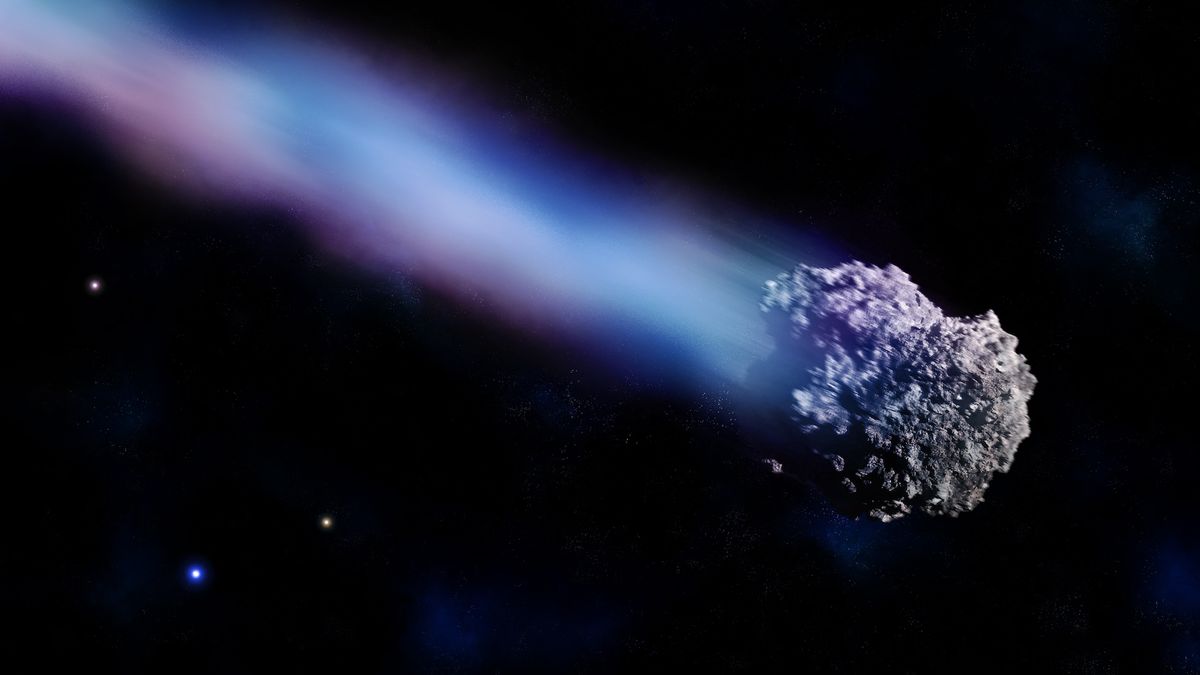Comets that rarely swing past the sun could ram into our planet, but we could spot them using the “crumb”-like meteoroid trails they leave behind, a new study suggests.
Many comets visit the solar system fairly often, at least on a cosmic timescale. Halley’s Comet, for instance, whizzes past Earth every 76 years, with its last appearance in 1986.
But other comets, like October’s A3 Tsuchinshan-ATLAS, are much more infrequent visitors. Some of these objects, born in the solar system‘s outer fringes, are long-period comets (LPCs) that only come close to the sun every 200 years or more.
While LPCs may enthrall skywatchers, they’re challenging for planetary defenders. Estimates indicate they may cause up to 6% of all impacts on Earth. However, few LPCs that could pose a threat — the ones whose orbits come within about 4.65 million miles (7.5 million kilometers) of Earth, or about one-twentieth the distance between Earth and the sun — have actually been discovered. Each of these potentially hazardous comets could pack a powerful punch. For instance, an asteroid with a diameter of 0.6 mile (1 km) traveling at 30 miles per second (50 kilometers per second) would impact Earth with the energy of 750,000 megatons of TNT.
But the new study proposes a way to detect LPCs: by following the “bread crumb” trails of meteoroids that these celestial Hansels have left behind. That’s because when a comet approaches the sun, intense solar heat vaporizes much of its ice. This ejects the comet’s rocks and dust into a meteoroid stream, whose path parallels the comet’s. Plus, “streams from long period comets specifically aren’t as prone to perturbations from the larger planets,” Samantha Hemmelgarn, a graduate student at Northern Arizona University and the study’s first author, told Live Science in an email.
Related: ‘God of chaos’ asteroid may be transformed by tremors and landslides during 2029 flyby of Earth, study finds
If Earth barges through the meteoroid streams, a portion may blaze through our planet’s atmosphere as meteor showers. These streaks can reveal the meteoroids’ speed and direction of travel, allowing scientists to extrapolate the streams and discover the parent comets. And while most LPCs are too faint for current observatories, the upcoming Legacy Survey of Space and Time (LSST) — which will use the forthcoming Vera C. Rubin Observatory‘s supervision — may detect these comets years before they pose a threat. Exactly how far in advance, however, wasn’t clear.
To determine this and to test their theoretical strategy, the new study’s authors turned to 17 meteor showers with known parent LPCs. Based on each shower’s properties, the researchers generated a bunch of synthetic LPCs — one family for each meteoroid stream. Then, the team virtually placed the comet clusters at distances that would make them bright enough only for the Rubin Observatory to see. Finally, the researchers compared the locations of these synthetic comet families with the real comets’ positions (when they would be as bright as their artificial counterparts) to see how well they matched.
The authors found that the positions of the actual parent comets largely lay within the clouds of synthetic comets, with most close to the centers of their respective artificial clusters. The researchers also found that back-projecting the meteoroid streams helped narrow down the area to look for parent comets. More importantly, they found that identifying comets as Earth impactors when they were billions of miles away gave years more warning time. Spotting large impactors this way could be especially helpful, buying more than a decade of prep time.
The scientists plan to use the new study’s techniques and images from the LSST to hunt for the LPC parents of currently orphaned meteoroid streams, Hemmelgarn said. She noted that 247 meteoroid streams whose paths cross Earth’s (listed in a 2023 guidebook co-authored by Peter Jenniskens, the study’s senior author) belong to this category.
“Hopefully with LSST, we will be able to detect comets on Earth crossing orbits much sooner than we can now,” she said.
However, even this technique has limitations. For example, it cannot pick out dangerous comets with an orbital period of more than 4,000 years, Hemmelgarn said, since “their meteor streams would be too dilute to be detected at Earth.”
The study, which has been accepted for publication in The Planetary Science Journal, is available as a preprint via arXiv.
